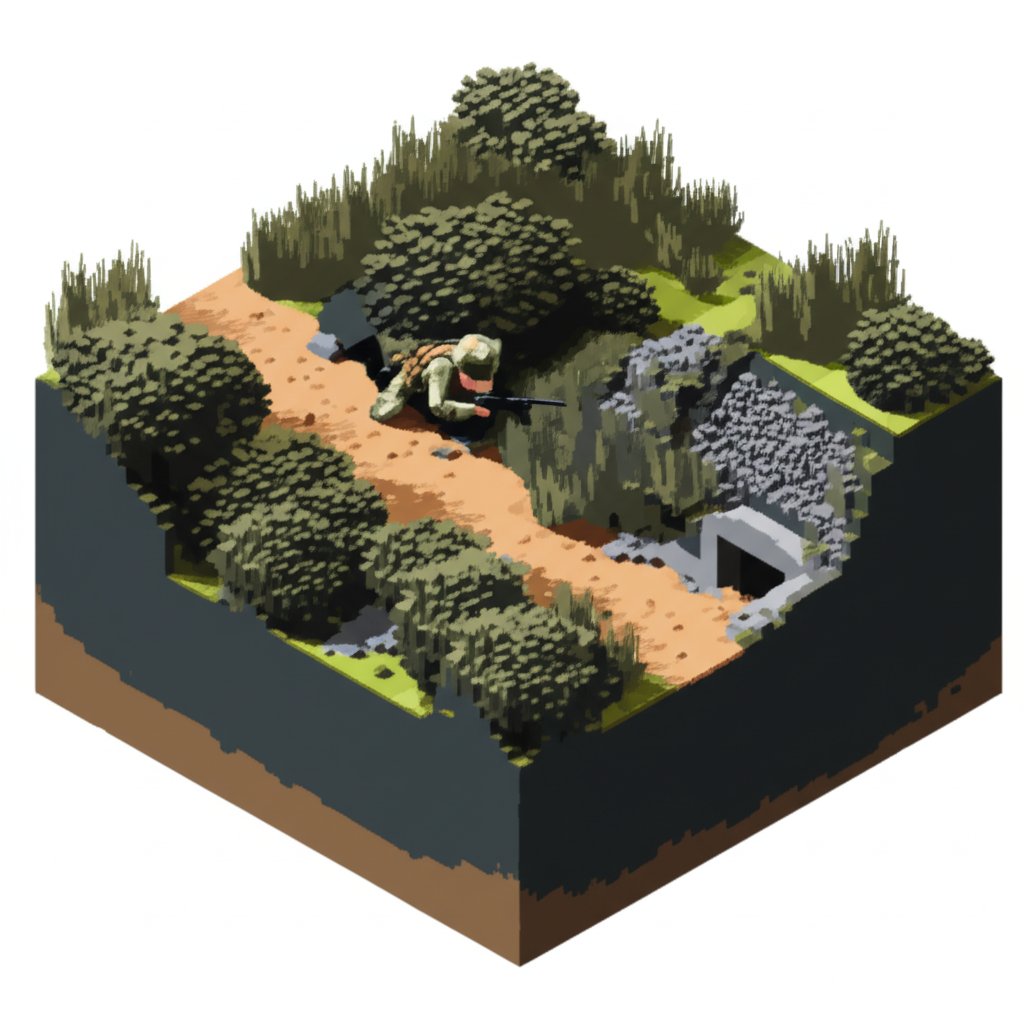In the annals of warfare, few concepts hold as much allure and decisive power as the military ambush strategy. It’s the ultimate demonstration of intellect over brute force, a symphony of deception, timing, and precision that has repeatedly turned the tide of battles and wars. This article plunges into the fascinating world where military strategy converges with military cunning, revealing the timeless tactics employed by history’s greatest tacticians to achieve overwhelming victory. From ancient battlefields to modern conflicts, we will uncover how masters of the military ambush outsmarted superior forces, cemented their legacies, and forever altered the course of human events.
Defining Military Ambush, Strategy, and Cunning

To truly appreciate the genius of great tacticians, it’s crucial to understand the fundamental components of their craft. The terms military strategy, military tactics, military ambush, and military cunning are often used interchangeably, but each plays a distinct and vital role in the art of war.
What is Military Ambush?
At its core, a military ambush is a surprise attack from concealed positions upon a moving or temporarily halted enemy. It’s designed to disorient, incapacitate, and destroy the target with maximum efficiency and minimal risk to the ambushing force. Successful ambushes hinge on deception, terrain exploitation, and precise timing. The goal is not just to inflict damage, but to break the enemy’s will to fight, often leading to a rout. History is replete with examples where a well-executed ambush decided the fate of empires, showcasing its potent military tactics.
The Essence of Military Strategy
Military strategy is the overarching plan or “grand design” for achieving long-term objectives in a war or conflict. It involves the art of planning and directing overall military operations and movements in a campaign or war. Strategy considers the political, economic, and logistical factors alongside purely military ones. It dictates where and when to fight, what resources to commit, and how to shape the conflict to one’s advantage, often setting the stage for tactical successes, including the perfect military ambush.
Military Tactics vs. Strategy
While military strategy is the big picture, military tactics are the specific methods and maneuvers used to achieve objectives in a particular engagement or battle. Tactics focus on the execution of plans on the battlefield – troop formations, movement, engagement, and disengagement. A brilliant military strategy can be undermined by poor military tactics, just as superior military tactics might be futile without a sound military strategy. The military ambush is a potent tactical tool, an integral part of a larger strategic framework.
The Role of Military Cunning
Military cunning is the often-underestimated ingredient that elevates good strategy and tactics to greatness. It represents the theory and practice of concealing one’s actions, creating diversions, and misleading an adversary to gain an advantage. Military cunning is the antithesis of predictable, rigid patterns; it’s about outsmarting an opponent, often against numerical or technological superiority. It’s a force multiplier, enabling victory with reduced expenditure of force, time, and resources. From feigned retreats to psychological operations, military cunning is the hallmark of history's greatest tacticians.
The Masters of Deception: History’s Greatest Tacticians
Across millennia, certain commanders have distinguished themselves through their innovative use of military ambush strategy and profound military cunning. These individuals weren’t just leaders; they were chess grandmasters on the battlefield, manipulating their opponents into fatal traps.
Hannibal Barca: The Cannae Masterpiece
No discussion of military ambush or military cunning is complete without Hannibal Barca. The Carthaginian general inflicted one of history’s most devastating defeats upon the Roman Republic at the Battle of Cannae (216 BC). Hannibal’s military strategy was to draw the Romans into a battle on ground of his choosing, then employ a double envelopment. His infantry formed a crescent, weakest in the center, which gradually yielded ground, luring the superior Roman forces deeper into the trap. Simultaneously, his cavalry routed the Roman cavalry on the flanks and then encircled the Roman infantry from behind. This wasn’t a hidden attack in the traditional sense, but a master-class in psychological manipulation and tactical maneuver, a grand military ambush on an open field. The result was the near-annihilation of the Roman army, a testament to Hannibal’s prowess as one of history's greatest tacticians.
Sun Tzu: The Art of War’s Ambush Philosophy
Though not known for a single famous ambush battle, Sun Tzu, the legendary Chinese military strategist, codified the principles that undergird every successful military ambush. His seminal work, “The Art of War,” emphasizes deception, surprise, and knowing both yourself and your enemy. He famously stated, “All warfare is based on deception.” Sun Tzu’s philosophy on military cunning involves striking where the enemy is unprepared, appearing where you are not expected, and manipulating perceptions. His teachings are the bedrock of military strategy and military tactics, inspiring commanders for millennia to employ feigned weakness, indirect approaches, and the psychological effects of unexpected attacks.
Alexander the Great: Tactical Surprise and Speed
Alexander the Great, a visionary who forged one of the largest empires of the ancient world, showcased unparalleled strategic foresight and tactical brilliance. While his battles often involved direct confrontation, his use of rapid marches, unexpected flanking maneuvers, and capitalising on enemy weaknesses bordered on the realm of military ambush. At the Battle of Gaugamela (331 BC), facing a numerically superior Persian army, Alexander employed an audacious oblique advance, tempting the Persian chariots to charge, creating a gap in their lines which his Companion Cavalry exploited, striking at the heart of Darius’s force. His military cunning lay in his ability to anticipate and provoke enemy reactions, turning their strengths into vulnerabilities through sheer speed and aggressive, unexpected movements.
Genghis Khan: The Mongol’s Feigned Retreat and Encirclement
Genghis Khan and his Mongol hordes perfected the art of the feigned retreat, a classic form of military ambush. Their military tactics involved appearing to flee in disarray, drawing enemy forces into a pursuit, only to turn and unleash a devastating volley of arrows from their horse archers, followed by a swift encirclement. This military cunning was highly effective against more conventional armies, who often mistook the disciplined feint for genuine panic. The Battle of Kalka River (1223 AD) against the Rus’ principalities is a prime example, where the Mongols lured their opponents into a seven-day running battle before turning the tables and annihilating them. This sophisticated military ambush strategy cemented the Mongols’ reputation as formidable and unpredictable warriors.
Frederick the Great: Oblique Order and Deceptive Maneuvers
Frederick the Great, the Prussian king, revolutionized 18th-century warfare with his innovative military strategy and military tactics. His most famous contribution was the “oblique order,” a formation that concentrated attack on one flank of the enemy, while deceptively presenting a weaker, extended front. At the Battle of Leuthen (1757), Frederick’s forces marched stealthily behind a series of low hills, concealing their true intentions and movements from the superior Austrian army. By the time the Austrians realized the main attack was coming from their right flank, it was too late to redeploy effectively. This audacious military ambush strategy, combining secrecy, rapid maneuvers, and a deceptive formation, led to a crushing Prussian victory and solidified Frederick’s place as one of history's greatest tacticians.
Vo Nguyen Giap: Guerrilla Brilliance and Strategic Patience
In the 20th century, General Vo Nguyen Giap, leader of the North Vietnamese army, showcased how military cunning and military ambush could defeat technologically superior adversaries. Giap mastered both guerrilla and conventional warfare, often employing protracted engagements and unexpected concentrations of force. The Battle of Dien Bien Phu (1954) stands as his masterpiece, where his forces painstakingly hauled heavy artillery through dense jungle to positions overlooking the French fortress, completely undetected. This allowed them to launch a devastating surprise bombardment, effectively an operational-level military ambush, crippling the French defenses and leading to their ultimate defeat. Giap’s ability to blend military strategy with deep understanding of terrain and psychological warfare makes him a paragon of military cunning.
Other Notable Tacticians and Their Cunning
Many others have demonstrated exceptional military cunning and military ambush strategy. Scipio Africanus, who defeated Hannibal by adopting and adapting Carthaginian tactics; Miyamoto Musashi, the Japanese swordsman whose “Book of Five Rings” emphasized psychological warfare and deception; and more modern figures like Erwin Rommel, the “Desert Fox,” known for his audacious and unexpected armored thrusts. Each, in their own context, refined the art of surprise and deception, proving that the mind is often the most powerful weapon on the battlefield.
Principles of Effective Military Ambush Strategy

While the specifics of a military ambush vary with terrain, technology, and enemy, certain fundamental principles endure through history. Adherence to these principles is what separates a successful military ambush from a catastrophic failure.
Deception and Misdirection
The cornerstone of any military ambush strategy is tricking the enemy. This involves convincing them that the ambush site is safe, that the ambushing force is elsewhere or weaker, or that the main attack will come from a different direction (military cunning). This can be achieved through false intelligence, feigned troop movements, creating diversions, or exploiting enemy biases and expectations.
Surprise and Speed
A military ambush loses its effectiveness without surprise. The enemy must be caught unawares, giving them no time to react, organize defenses, or call for reinforcements. Once the ambush is sprung, the attack must be delivered with overwhelming speed and violence to maximize shock and immediately gain the upper hand.
Terrain Exploitation
History’s greatest tacticians have always understood the importance of terrain. Natural cover and concealment, choke points, and avenues of escape are crucial for setting up a military ambush. The terrain should offer the ambushing force advantages in terms of observation, firing positions, and protected withdrawal, while simultaneously hindering the enemy’s movement and counter-attack capabilities.
Coordination and Discipline
A military ambush is a complex operation requiring meticulous planning and flawless execution. All elements of the ambushing force—from reconnaissance to the main assault—must be perfectly coordinated. Troops must be highly disciplined, maintaining absolute silence and stillness until the precise moment of attack, and then acting with unified purpose.
Retreat and Follow-through Planning
A military ambush strategy isn’t just about striking; it’s also about anticipating the aftermath. Commanders must plan for the enemy’s potential reactions, including counter-attacks or attempts to break out. Planning for a rapid, organized disengagement (if the goal is harassment rather than annihilation) or for a decisive pursuit and exploitation of the scattered enemy (if aiming for destruction) is vital for maximizing the tactical gain and minimizing risk.
The Enduring Legacy of Military Cunning in Modern Warfare
The principles of military ambush strategy and military cunning developed by history's greatest tacticians remain acutely relevant in today’s complex battlefields, even as technology evolves. While the spears and cavalry charges have been replaced by drones and cyber weapons, the human element of deception and surprise persists as a critical factor in military strategy.
Information Warfare and Cyber Ambushes
In the digital age, military cunning often manifests as information warfare. Cyber attacks can function as high-tech military ambushes, disabling infrastructure, disrupting communications, or stealing critical intelligence without a single shot being fired. These operations rely on stealth, exploitation of vulnerabilities, and precise timing, mirroring the principles of traditional ambushes. Disinformation campaigns and psychological operations are modern expressions of deceiving the enemy and manipulating their decision-making.
Psychological Operations (PsyOps)
Modern military strategy heavily incorporates psychological operations (PsyOps) to influence the emotions, motives, and reasoning of enemy forces and populations. This is a direct descendant of military cunning, aimed at wearing down an adversary’s morale, inciting internal dissent, or creating a perception of overwhelming strength or weakness. The goal is to achieve objectives without direct combat, or to soften up an enemy before a conventional engagement, making them more susceptible to military tactics like ambushes.
Adaptability and Unpredictability
The constant need to “outsmart” an adversary creates a perpetual cycle of innovation in deceptive practices, making military cunning a continually evolving discipline. Modern military strategy emphasizes adaptability, flexibility, and unpredictability to keep potential adversaries off-balance. Commanders are trained to think outside conventional frameworks, to anticipate and exploit enemy assumptions, and to use every available tool – from advanced reconnaissance to special operations forces – to achieve tactical surprise. The spirit of the military ambush lives on in these dynamic and often concealed approaches.
Conclusion
The study of military ambush strategy is a journey through the minds of history's greatest tacticians. From Hannibal’s double envelopment at Cannae to Giap’s hidden artillery at Dien Bien Phu, the thread of military cunning and ingenious military tactics weaves through every decisive victory. These commanders understood that warfare is not merely a clash of arms, but a contest of wills and intellect. By mastering deception, exploiting terrain, and striking with surprise and speed, they demonstrated that even against overwhelming odds, a well-conceived military ambush can alter the course of history. The enduring legacy of these masters continues to shape military strategy today, reminding us that knowledge, foresight, and audacious military cunning remain the ultimate weapons in the art of war.
FAQ Section
Q1: Who were some of the most renowned masters of military ambush and cunning throughout history?
A1: Some of the most renowned masters include Hannibal Barca, famous for the Battle of Cannae; Sun Tzu, whose “Art of War” codified principles of deception; Alexander the Great, known for tactical surprise; Genghis Khan, master of the feigned retreat; Frederick the Great, who perfected the oblique order; and Vo Nguyen Giap, a genius in guerrilla and conventional ambush tactics.
Q2: What were the key tactics and strategies employed by these master tacticians to achieve victory?
A2: Common military tactics and military strategy employed by these masters include:
Q3: Can you provide specific examples of successful ambushes and stratagems executed by these military leaders?
A3: Certainly:
Q4: How did the military innovations and leadership of these masters influence the course of warfare and military strategy?
A4: These masters profoundly influenced military strategy by:
military cunning and superior military tactics could overcome numerical disadvantages.military strategy and military tactics.Q5: What are some of the common traits and characteristics that these master tacticians shared?
A5: History's greatest tacticians often shared several key characteristics:










